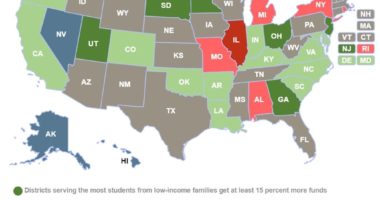Vision: Ensuring all children in Kent County have an equitable path to economic prosperity through family, quality education, and community supports
By: Katie Adrianse, Director of Communications, Maegan Frierson, Director of System Building, and
Mark Woltman, Vice President
KConnect is a collective impact organization dedicated to ensuring all children and families in Kent County, Michigan, have equitable opportunities to thrive from cradle to career. Rooted in collaboration and systems change, KConnect is working with cross-sector partners to address the gap in diverse educators, in alignment with our comprehensive workplan. With the use of a 360-degree framework, which seeks to inspire, train, recruit, and retain, the KConnect network’s goal is to double the number of educators of color by the year 2033 to approximately 442 Black educators and 334 Latine educators.
Over the past year, Kent County has made significant strides in diversifying its educational workforce. Since 2019, there has been a 35% increase in Black teachers and a 30% increase in Latine teachers in the district, as reported on KConnect’s publicly available data dashboard. Even with the increase, a significant gap still exists.
Kent County is made up of approximately 30% people of color, while Kent ISD is approximately 6.5% educators of color. In order for Kent ISD to mirror county demographics, we would need to hire 1,973 more educators of color. (KConnect, n.d.) To put that into perspective, there are 1,691 Latine educators in the state of Michigan (MI School Data, 2024). Kent ISD would have to hire nearly 50% of them to close the gap. This illustrates the stark reality that we cannot simply hire our way out of this situation; instead, we need to rely on tools such as the 360-degree model to solve this systemic issue.
As a region with a growing and diverse student population, the underrepresentation of educators who reflect the cultural, racial, and ethnic identities of the students creates barriers to fostering inclusive and affirming school environments. Studies consistently show that students benefit academically and socially when taught by educators who share similar lived experiences, as it enhances cultural understanding, representation, and student engagement (Gerber, 2022).
In addition to the gap in the teacher pipeline, significant pay gaps exist between districts in Kent County. A new teacher with a master’s degree earns $6,500 more in their first year at the highest-paying district compared to the lowest (KConnect, 2024). For veteran teachers, the gap widens, with potential yearly differences reaching over $18,000 (KConnect, 2024). Over a career, this disparity can amount to approximately $320,000 in lifetime earnings for those in the highest-paying districts compared to the lowest-paying. This is a statewide issue that is not unique to Kent County, and will require systemic, multifaceted solutions at every level of educational leadership and policymaking.
KConnect has two system-level recommendations to improve the diversity of the educator pipeline:
- Improve teacher pay, specifically in lower-paying districts. To address this gap, KConnect prioritizes “Equity in Teacher Compensation” on its Shared Policy Agenda. We recommend that community leaders advocate at a local, state, and national levels for policies and practices that support an increase in teacher pay.
- Develop initiatives that support educators of color. In 2023, KConnect helped to launch the Shades of Strength Collaborative, a network of educators and system leaders who are committed not only to providing support, but also developing actionable solutions to address disparities for educators of color in our community. KConnect recommends that other communities develop similar supports, especially for new educators entering the workforce.
References:
- Gerber, N. (2022, April 28). Teachers of color: Role models and more. National Council on Teacher Quality.
https://www.nctq.org/blog/Teachers-of-color:-Role models-and-more - KConnect. (2024). 2022-23 Kent ISD salary schedules.
- KConnect. (n.d.). Culturally responsive instruction. https://apps.johnsoncenter.org/kconnect/successmeasure.jsp?SuccessMeasureID=47&lang=en
- MI School Data. (2024). Staffing Count. https://bit.ly/kconnectanalysis
This blog was featured in EdTrust-Midwest’s report, Closing the Opportunity Divide: Addressing Michigan’s Teacher Shortage Problem for Students Most in Need.






